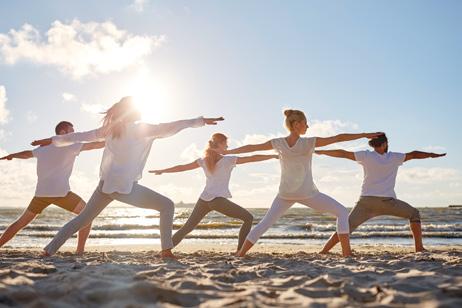
3 minute read
Green Exercise
Reconnecting With Nature
by Cristina Parker
For some fitness buffs, it doesn’t feel like exercise unless they’re at the gym lifting weights, pedaling the stationary bike or hearing the grunts of others giving it their all. But there’s an emerging trend taking hold: green exercise. Prompted by a growing focus on reconnecting with nature, combined with the well-known benefits of physical exertion, outdoor workouts in natural settings and urban parks are all the rage.
From daily walks around the neighborhood to calisthenics with the aid of a tree or yoga on the beach, the possibilities are delightfully endless for all ages and fitness levels. Medical pros are prescribing it for science-based reasons.
Green exercise is not exactly a new concept. In a 2013 review of studies published in Extreme Physiology & Medicine, researchers concluded that physical activity in a natural setting as opposed to an indoor gym is perceived as easier and more fun, thereby boosting motivation. They wrote, “The nature element may help achieve a greater intensity of exercise without perception of effort changing.” In other words, people walk faster outdoors yet paradoxically feel as though they’re kicking back.
The U.S. Department of Agriculture found a positive correlation between green space and health. People that spend time in nature often experience a reduction in stress, cortisol levels, muscle tension and heart rate—all of which are risk factors for cardiovascular disease. A 2021 study published in Frontiers in Psychology involving obese young people confirmed that exercising in nature led to improved stress recovery, enhanced attentional restoration and a reduction in negative emotions.
Exposure to sunlight is another benefit. According to Dr. Natty Bandasak, a physical therapist and founder of The Myokinetix Clinic, in New Jersey, “Getting vitamin D from the sun is much more impactful than the vitamin D absorbed from ingestible supplements. Just 10 minutes spent outside first thing in the morning can really set the day in a good direction.”
To maximize the benefits of green exercise, Rajeshwari Reddy, a physical therapist in Maryland, suggests a few precautions. “If you have any kind of vision issues, you should exercise midday when there is enough light to keep yourself safe, and if you suffer from seasonal allergies, try to avoid areas with flowering plants or trees,” she explains. “Standard walking shoes are different from running shoes, and the body mechanics of different activities require different levels of shock absorption. These often-overlooked components of an outdoor exercise routine can go a long way to keep you safe, avoid unnecessary injuries and ensure you are having fun with your new program.”
After choosing a suitable time and location, the next step is deciding what exercises to do. Dr. Christine Masterson, a physical therapist at Orlin & Cohen Orthopedic Group, in New York, says, “For those who desire supervision, joining a local walking or running group is an excellent option. Alternatively, for those who prefer independence, a self-paced exercise routine is recommended.”
Both Masterson and Bandasak describe bodyweight-supported exercises as a perfect outdoor-friendly, equipment-free workout. Moving against gravity uses the person’s weight as a natural form of resistance. As a result, no dumbbells or resistance bands are required. Pick a nice spot in the grass, on the sand or under a shaded treat and do sit-ups, heel raises, push-ups and squats.
Masterson suggests pairing calisthenics with walking. A sample routine could include a brisk walk to the park, followed by squats sitting and standing from a bench, then another brisk walk to a wooded area, followed by heel raises holding onto a tree trunk for balance. “In a bodyweight program, you can focus more on your form and movement pattern, then you can progress these exercises by increasing repetitions, rather than adding weights,” she notes.
Bandasak asserts that aerobic exercises like walking, jogging or hiking can be optimized by adding a grip challenge. “One factor strongly correlated with increased longevity is grip strength,” he explains. “Grip can be strengthened through your ability to hold onto objects like a pull-up bar at a playground or stable tree branch in nature. If those items are not available, just holding any heavy objects by your sides as you walk can be beneficial.”
A key, take-home message when beginning any green-exercise program is to keep an open mind. There are so many activities we can enjoy outdoors. Reddy considers green exercise anything that gets the heart rate going, which can include diverse activities like golf, gardening in the backyard or swimming in a lake.
While getting the blood pumping, remember to breathe in the fresh air, listen to the songbirds and soak up the summer sunshine. Masterson is a proponent of outside yoga to refocus the mind and deeply reconnect with our surroundings.
To schedule a tour or for more information contact Ed Vogrins: 610-868-4840 | Info@GreenMeadowPA.org
1121 Graham Street • Fountain Hill, PA 18015






